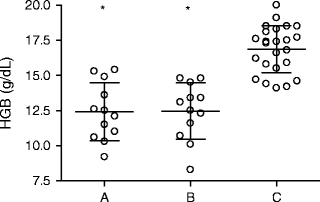T 0 Mean ± SD (C.I.95%)
T 60 Mean ± SD (C.I.95%)
P < 0.05
RBC (x106/μL)
5.64 ± 0.83 (5.11–6.17)
5.49 ± 0.8 (4.98–6.0)
n.s.
HGB (g/dL)
12.42 ± 2.04 (11.12–13.71)
12.46 ± 2.0 (11.19–13.73)
n.s.
HCT (%)
35.67 ± 6.01 (31.86–39.49)
35.43 ± 5.41 (32.0–38.87)
n.s.
MCV (fL)
60.99 ± 9.2 (55.15–66.84)
64.58 ± 3.4 (62.42–66.75)
n.s.
MCH (pg)
21.69 ± 2.24 (20.27–23.11)
22.72 ± 1.8 (21.58–23.86)
n.s.
MCHC (g/dL)
33.78 ± 4.44 (30.95–36.6)
35.15 ± 1.57 (34.15–36.15)
n.s.
SOD (U/gHGB)
114.2 ± 18.0 (102.7–125.6)
115.2 ± 21.6 (101.5–129.0)
n.s.
GSHPx (U/L)
988.7 ± 222.3 (847.5–1130.0)
872.1 ± 271.9 (699.3–1044.8)
n.s.
Table 12.2
Hematological indices and activities of antioxidative enzymes in dogs with CanVL after Sbv therapy (T 60) and in healthy dogs (CTRL)
T 60 Mean ± SD (C.I.95%) | CTRL Mean ± SD (C.I.95%) | P < 0.05 | |
|---|---|---|---|
RBC (x106/μL) | 5.49 ± 0.8 (4.98–6.0) | 6.94 ± 0.61 (6.68–7.2) | <0.0001 |
HGB (g/dL) | 12.46 ± 2.0 (11.19–13.73) | 16.86 ± 1.67 (16.16–17.57) | <0.0001 |
HCT (%) | 35.43 ± 5.41 (32.0–38.87) | 47.65 ± 4.55 (45.72–49.57) | <0.0001 |
MCV (fL) | 64.58 ± 3.4 (62.42–66.75) | 68.58 ± 2.78 (67.41–69.76) | <0.001 |
MCH (pg) | 22.72 ± 1.8 (21.58–23.86) | 24.3 ± 1.28 (23.76–24.84) | <0.01 |
MCHC (g/dL) | 35.15 ± 1.57 (34.15–36.15) | 35.43 ± 2.22 (34.49–36.37) | n.s. |
SOD (U/gHGB) | 115.2 ± 21.6 (101.5–129.0) | 82.6 ± 9.0 (78.8–86.4) | <0.0001 |
GSHPx (U/L) | 872.1 ± 271.9 (699.3–1044.8) | 1025.3 ± 284.6 (905.2–1145.5) | n.s. |
12.4 Discussion
Results of our study revealed that the presence or absence of a previous treatment with Sbv had no statistically identifiable effect on antioxidative enzyme activities and hematological indices. No significant differences in SOD and GSHPx activities and hematological indices were detected in dogs with CanVL before and after therapy with Sbv (T 0 and T 60). Erythrocyte SOD activities were significantly higher and HGB, RBCs, HCT, MCV, and MCH levels were significantly lower in dogs with CanVL at 60 days after therapy as compared to clinically healthy dogs (Figs. 12.1 and 12.2). On the basis of these findings, we assume that these parameters are significantly altered in dogs with CanVL as compared with those of control dogs, regardless of the Sbv treatment. This result suggests that in dogs with CanVL, Sbv therapy does not improve the redox state or the underlying anemia. This may be explained, at least in part, by other antioxidative systems not evaluated in this study, by the degree of renal impairment or failure, which is not always detectable through routine tests (Ciaramella et al. 1997), or by the fact that the Sbv therapy alone may not be sufficient to determine the improvement of the hematological indices and redox states in dogs with CanVL (Erel et al. 1999). For example, in hamsters with experimental visceral leishmaniasis, the combination of antioxidants, such as α-tocopherol, ascorbic acid, and flavonoids, with the Sbv therapy resulted in a greater reduction of ROS and parasitemia (Sen et al. 2005), and a greater increase in HGB concentrations and RBC half-lives as compared to the Sbv therapy alone (Sen et al. 2004). It is important to note that while the levels of SOD activity and hematological indices in dogs with CanVL were similar before and after therapy with Sbv, but significantly different as compared to those of control dogs, the levels of GSHPx activities before therapy were similar to that of control dogs, and were basically reduced after Sbv therapy (Fig. 12.3). As previously reported during chronic experimental infections in hamsters (Sen et al. 2001) and cutaneous leishmaniasis in humans (Kocyigit et al. 2003), this finding, although without statistical significance, may suggest a depletion of the GSHPx antioxidative system during chronic CanVL infections in dogs. However, the lack of a statistical significance for this finding underlines the need for increased sample size. Interestingly, pretreatment GSHPx activity is positively related with the progression of anemia, while pretreatment SOD activity is inversely related. Although significant, the coefficient of determination R 2 of the developed algorithm indicates that these relationships are weak. Thus, despite a 50% variance in posttreatment HGB concentrations, this may be explained by the variance of pretreatment SOD and GSHPx activities, and the remaining percentage is due to other factors, such as low iron concentrations, renal or bone marrow impairment, or other antioxidative systems not considered here. Nevertheless, the normal distribution of the data and the absence of colinearity between SOD and GSHPx activities support the evaluation of different pretreatment antioxidative systems that may be predictive or protective against the oxidative damage involved in anemia during CanVL. To the authors’ knowledge, this is the first study on the comparison of SOD and GSHPx activities in dogs with CanVL before and after therapy with Sbv. As previously observed during CanVL (Bildik et al. 2004), RBCs are exposed to an oxidative stress that could be responsible for their premature removal from circulation. Our results suggest that this damage persists even after Sbv therapy. A study is in progress to examine the efficacy of the combination of antioxidants with the Sbv therapy in dogs with CanVL.




